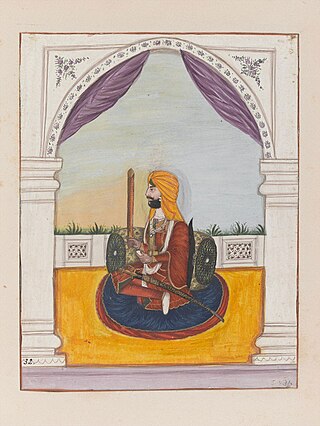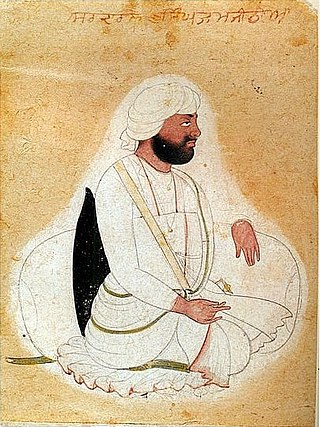
Diwan Dina Nath (1795—1857), was an official of the durbar (court) of the Sikh Empire, whom served as the privy seal and finance minister, and later was conferred the title of Raja by Maharaja Ranjit Singh.

Hari Singh Nalwa was Commander-in-chief of the Sikh Khalsa Fauj, the army of the Sikh Empire. He is known for his role in the conquests of Kasur, Sialkot, Attock, Multan, Kashmir, Peshawar and Jamrud. Hari Singh Nalwa was responsible for expanding the frontier of Sikh Empire to beyond the Indus River right up to the mouth of the Khyber Pass. At the time of his death, the western boundary of the Empire was Jamrud.

Maharaja Gulab Singh Jamwal (1792–1857) was the founder of Dogra dynasty and the first Maharaja of the princely state of Jammu and Kashmir, which was a part of Panjab and Sikh Empire became the largest princely state under the British Raj, which was created after the defeat of the Sikh Empire in the First Anglo-Sikh War. During the war, Gulab Singh would later side with the British and end up becoming the Prime Minister of Sikh Empire. The Treaty of Amritsar (1846) formalised the transfer of all the lands in Kashmir that were ceded to them by the Sikhs by the Treaty of Lahore.

The Battle of Jamrud was fought between the Emirate of Afghanistan under Emir Dost Mohammad Khan and the Sikh Empire under Maharaja Ranjit Singh on 30 April 1837. Afghan forces confronted the Sikh forces at Jamrud. The garrisoned army was able to hold off the Afghans till Sikh reinforcements arrived to relieve them.

Ranjodh Singh was a powerful member of the Sikh aristocracy and governor of Hazara. The Majithia family are Jat of the Shergill gotra (clan), and were particularly influential in the area near their headquarters in Majithia.

The Nakai Misl, founded by Sandhu Jats, was one of the twelve Sikh Misls that later became the Sikh Empire. It held territory between the Ravi and Sutlej rivers southwest of Lahore in what became Pakistan. The misl fought against the Sials, the Pathans and the Kharals before it was incorporated into the Sikh Empire of the Sukerchakia Misl by Ranjit Singh.

Sardar Charat Singh, also romanised as Charhat Singh, was the founder of Sukerchakia Misl and father of Mahan Singh, and the grandfather of Ranjit Singh. He distinguished himself at an early age in campaigns against Ahmad Shah Abdali and along with 150 horsemen split from the Singhpuria Misl to establish the Sukerchakia Misl.

Rani Sada Kaur was a Sikh leader. She served as the Chief of the Kanhaiya Misl from 1789 to 1821, following the death of her husband Gurbaksh Singh Kanhaiya, the heir to Jai Singh Kanhaiya, the leader of the Kanhaiya Misl, and she is sometimes referred to as Sardarni Sada Kaur.

Lehna Singh Majithia, his personal name is also romanized as Lahina or Lahna, was a polymath, inventor, warrior, and statesman. Lehna Singh was the father of famous businessman and philanthropist, Dyal Singh Majithia.
Manawala is a city in Sheikhupura District, Punjab, Pakistan. It is situated on the Lahore-Sheikhupura-Faisalabad road.
Kunwar Tara Singh, sometimes styled as Shahzada was the younger of the twins of Maharaja Ranjit Singh, founder of Sikh Empire and his first wife Maharani Mehtab Kaur. His elder twin brother was Maharaja Sher Singh, who briefly became the ruler of the Sikh Empire from 1841 until his death in 1843.
Kunwar Ishar Singh was the son of Ranjit Singh, Maharaja of the Sikh Empire and his first wife Maharani Mehtab Kaur of the Kanhaiya Misl. Ishar Singh was the first son of Mehtab Kaur and the second son of Ranjit Singh, as his second wife Maharani Datar Kaur of the Nakai Misl gave birth to his first son and heir apparent in 1801.
Sardar Hukma Singh was the Governor of Attock and Hazara in the Sikh Empire from 1818 to 1820. He was a rajput of geharwar of Kashyapa Gotra.
Sardar Ran Singh Nakai was the third chief of the Nakai Misl. He was born to the aristocratic Sandhu family of Jat Sikhs. He distinguished himself at an early age in campaigns with his father, Natha Singh Sandhu and uncle, the legendary Heera Singh Sandhu who was the founder of the Misl. Ran Singh was a fierce warrior and a powerful misldar under his leadership the misl was at its highest. He was the father of Maharani Datar Kaur and the father-in-law of Maharaja Ranjit Singh, the founder of the Sikh Empire. He was the grandfather of Maharaja Kharak Singh, the second king of the Sikh Empire and Sardar Kahan Singh Nakai, the last chief of the Nakai Misl.
Sardar Kahan Singh Nakai was the sixth and the last chief of the Nakai Misl. He was the grandson of the famous Sikh chief, Ran Singh Nakai and Sardarni Karmo Kaur. His aunt, Maharani Datar Kaur was the wife of Maharaja Ranjit Singh, founder of the Sikh Empire; thus making him the nephew of the Sher-e-Punjab. From an early age he assisted his father in campaigns and even commanded campaigns assigned to him by his uncle, Maharaja Ranjit Singh. His cousin, Kharak Singh went to become the second Maharaja of the Sikh Empire. He was the uncle of the third Maharaja, Nau Nihal Singh.
Sultan Mahmud Khan was a commander of the Sikh Khalsa Army, the army of Sarkar e Khalsa. His derah of artillery was designated as Topkhana Sultan Mahmud. He is regarded as one of the best commanding officers of Maharaja Ranjit Singh.
Diwan Bhawani Das was a high-ranking Hindu official under Durrani emperors, Zaman Shah and Shah Shujah. He later became the revenue minister of Maharaja Ranjit Singh, ruler of the powerful Sikh Empire.
The Battle of Taragarh was fought in 1822 by the Sikh forces led by Amar Singh Majithia and the Afghan tribesmen led by Mohammad Khan Tarain.
Mughalchak is a town in Gujranwala District, Punjab, Pakistan.








